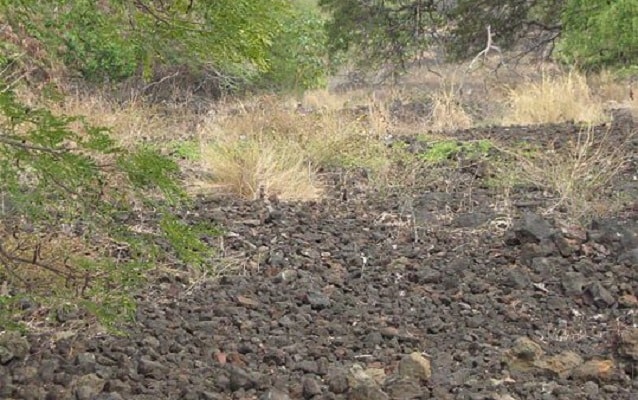Last updated: August 16, 2019
Place
Keauhou Holua Slide

Photo by W Nowicki, CC BY 3.0 https://commons.wikimedia.org/w/index.php?curid=6440309
The hōlua slide at Keauhou in Kailua-Kona, on the Island of Hawai'i, is the largest and best preserved slide in the State of Hawaii. He'e hōlua, "sled surfing, or "land sledding," was a popular sport in Hawaii. A hōlua slide was made of rocks that were covered in fresh dirt and reeds making a slick, sloping surface which was then lubricated with kukui (candlenut) oil. Individual riders rode down the slide on a papa hōlua (sled) made from local trees, often reaching speeds of up to 60 miles per hour. The Keauhou Holua Slide snakes downward for 1,300 feet, from the top of a hill onto the edge of a modern street. Although the slide now ends at Kaleiopapa Street, archeologists estimate it once spanned 4,000 feet and probably deposited the riders into Keauhou Bay.
He'e hōlua was a prestigious sport in the Hawaiian Islands. It was played mostly during Makahiki, the four-month winter New Year's celebration in honor of the agricultural, rain, and fertility god Lono. During this time, Hawaiians would gather at Keauhou Bay to watch the He'e hōlua races. Only the Hawaiian ali'i (chiefs) were allowed to compete in the races. An ali'i'spapa hōlua, which was carved from wood by hand and took several weeks to produce, was treated with pride. A papa hōlua was long and narrow with two runners held apart by crosspieces. Two smaller rails sat on top of the crosspieces and acted as a platform and the whole sled was lashed together with coconut fiber. The sled could be as long as 14 feet and weigh as much as 50 pounds.
The papa hōlua's design allowed riders a choice of different riding techniques on their journey to the bottom of the slide, with two techniques being the most popular. Riders using the first technique would stand sideways on the papa hōlua, kick with one foot to launch themselves, and then put both feet on the sled and extend their arms for balance – much like a modern snowboard rider. Sliders using the second technique would jump onto the papa hōlua chest-down, face forward, and grip the narrow sled tightly for control. Both techniques allowed skilled sliders to steer the papa hōlua by shifting their body weight. Control of the papa hōlua was essential because many he'e hōlua courses, like the one at Keauhou, featured a curving track. A mistake or loss of control meant injury or possible death.
The risk of death only added to the excitement of the sacred sport. Spectators gambled passionately on the races, and the racers themselves would sometimes bet against each other. Ali'i frequently wagered their own papa hōlua. When some ali'i lost they would voluntarily offer "double or nothing" wagers.
Whatever the outcome, every he'e hōlua race was an intense display of physical fitness and spiritual devotion. According to the reports of Christian missionaries, unmarried racers and spectators often erupted into spontaneous celebration after particularly exciting races. Historians attribute the decline of hōlua sliding, as well as other traditional Hawaiian sports and customs, to Christian missionaries and the replacement of local traditions with European culture. The he'e hōlua slide at Keauhou gradually fell into disuse during the 19th century as interest in traditional sports waned, but today the sport is being rediscovered and reintroduced to the islands.
